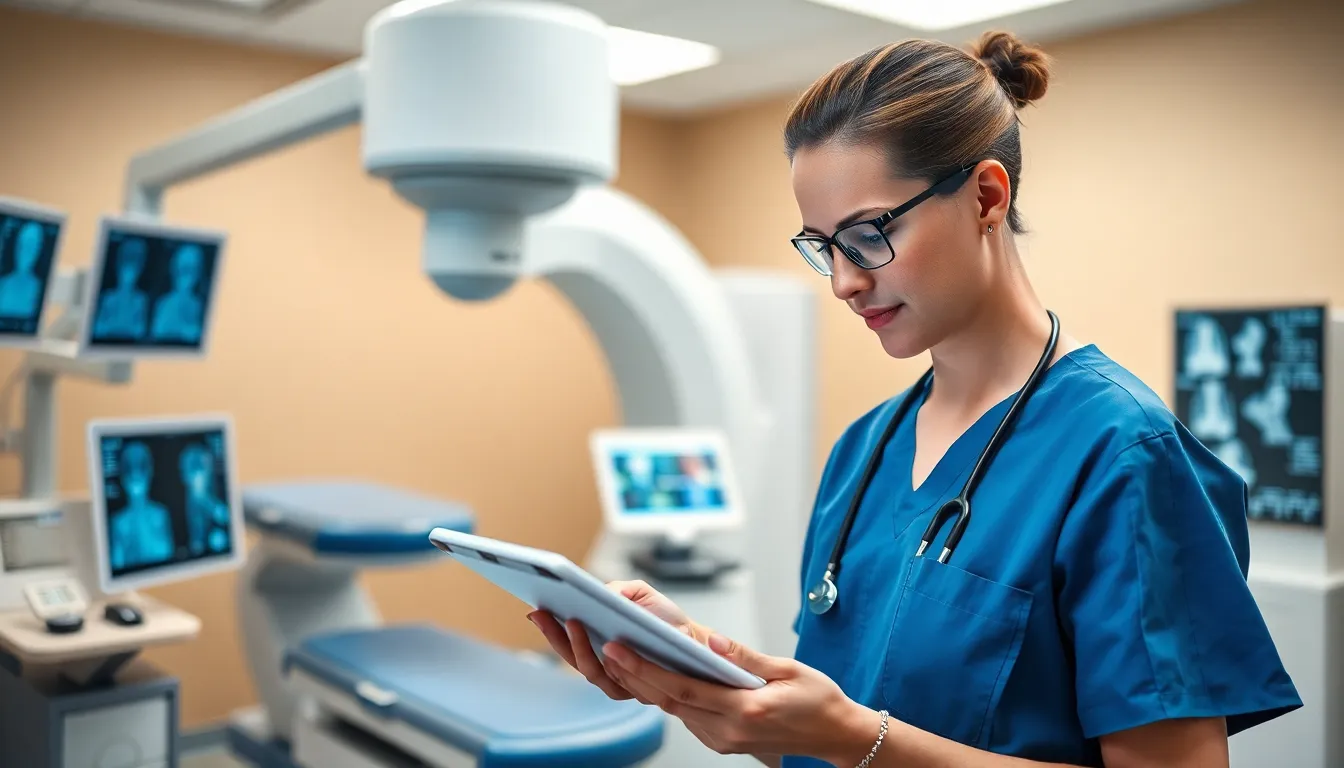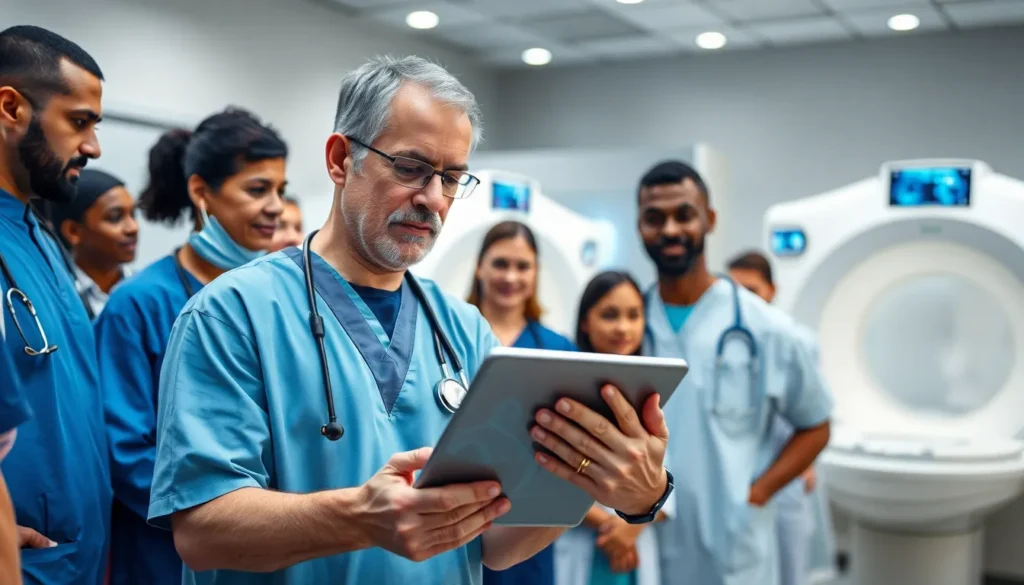In a world where even your toaster can be smarter than your average doctor, technology-enhanced medical diagnostics is shaking things up in healthcare. Gone are the days of guessing games and outdated methods. With cutting-edge tools and AI-driven insights, diagnosing medical conditions has never been faster—or more accurate.
Table of Contents
ToggleOverview of Technology-Enhanced Medical Diagnostics
Technology-enhanced medical diagnostics represent a significant advancement in healthcare. Tools powered by artificial intelligence now streamline the diagnostic process. These tools improve the accuracy and speed of identifying health conditions. Healthcare professionals rely increasingly on technology to make informed decisions.
Digital imaging techniques play a crucial role in diagnostics. Methods like MRI and CT scans utilize advanced software for better image interpretation. Machine learning algorithms can analyze patterns in imaging data, leading to earlier detection of diseases such as cancer. Such advancements enhance patient outcomes by enabling timely intervention.
Wearable devices also contribute to this revolution. Devices monitor vital signs continuously, providing real-time data. This data aids in the early recognition of potential health issues. Patients benefit from proactive care based on measurable metrics.
Telemedicine platforms facilitate remote diagnostics. They enable healthcare providers to consult with patients regardless of location. Physicians access diagnostic tests remotely, which helps in managing chronic conditions more effectively.
Big data analytics has transformed how data is utilized. The aggregation of patient information allows for trend identification and predictive modeling. Healthcare systems harness this information to personalize treatment plans, enhancing patient satisfaction and outcomes.
Robotic-assisted technologies streamline surgical diagnostics and procedures. Surgeons gain enhanced precision through these technologies, reducing recovery time. Such innovations make complex surgeries safer and more efficient.
The integration of these technologies reshapes the diagnostic landscape. As healthcare continues to evolve, technology-enhanced diagnostics will play a pivotal role in improving patient care and outcomes.
Key Technologies in Medical Diagnostics

Technology is revolutionizing medical diagnostics, with several key innovations enhancing accuracy and efficiency in the field.
Artificial Intelligence and Machine Learning
Artificial intelligence (AI) plays a crucial role in interpreting vast data sets in medical diagnostics. Machine learning algorithms analyze images from MRI and CT scans, leading to quicker and more precise disease detection. These tools reduce human error by identifying patterns that might go unnoticed by the naked eye. Numerous studies indicate that AI-driven solutions can classify conditions with up to 95% accuracy, aiding radiologists significantly. Enhanced predictive analytics provide healthcare providers with insights to intervene early, ensuring timely patient care.
Telemedicine and Remote Monitoring
Telemedicine transforms access to healthcare, allowing patients to consult with physicians from anywhere. This technology enables remote diagnostics, making specialized care available regardless of geographic barriers. Real-time monitoring through wearable devices captures vital signs continuously, sending data to healthcare providers for analysis. Platforms offering telehealth services report a 50% increase in patient engagement, promoting ongoing communication between patients and clinicians. Such advancements lead to proactive management of chronic conditions, ensuring comprehensive patient support and reducing hospital visits.
Impact on Patient Outcomes
Technology-enhanced medical diagnostics greatly affect patient outcomes, facilitating timely and accurate interventions. These advancements lead to significant improvements in healthcare delivery.
Improved Accuracy and Speed
Enhanced diagnostic tools, including AI algorithms, streamline the detection of conditions. AI-driven methods achieve up to 95% accuracy in image classification, allowing faster identification of diseases. Devices utilizing advanced imaging techniques, such as MRI and CT scans, contribute to early diagnosis, which is crucial for effective treatment. Machine learning enhances image interpretation, thus increasing precision in diagnostics. Patients benefit from quick results, which support prompt therapeutic decisions. Earlier detection of conditions effectively reduces the burden of diseases on healthcare systems.
Cost-Effectiveness
Cost savings manifest as technology streamlines diagnostic processes. Telemedicine platforms decrease the need for physical consultations, allowing providers to reach more patients efficiently. Remote consultations cut travel expenses and optimize resource allocation within healthcare facilities. Wearable devices, by continuously monitoring vitals, prevent costly interventions through early detection of potential issues. AI analytics guide personalized treatment plans, preventing unnecessary procedures, thus further reducing costs. Overall, these innovations contribute to sustainable healthcare by improving efficiency and reducing financial strain on patients and providers alike.
Challenges and Ethical Considerations
Technology-enhanced medical diagnostics bring challenges and ethical considerations that require careful attention.
Data Privacy and Security
Data privacy remains a significant concern in the realm of technology-driven diagnostics. Healthcare providers collect vast amounts of personal health information, which can be vulnerable to breaches. Ensuring compliance with regulations like HIPAA is crucial. Recent studies show that 50% of healthcare organizations faced a data breach in the past year. Organizations must implement robust cybersecurity measures to protect sensitive information. Encrypting data transmissions and securing electronic health records are steps that enhance confidentiality. Regular training for staff about data handling practices also strengthens security protocols.
Equity in Access
Equity in access poses another challenge within technology-enhanced diagnostics. Not all patients have equal access to digital tools and services. Rural populations, for instance, often lack high-speed internet or necessary devices, hindering their ability to engage in telemedicine. Research indicates that 30% of low-income individuals struggle to obtain adequate healthcare due to technological barriers. Addressing this disparity requires healthcare systems to find solutions, including subsidizing technology for underserved communities. Partnerships with organizations that provide access to digital resources can aid in promoting equity. Ensuring that all patients benefit from advancements in diagnostics ultimately enhances healthcare outcomes.
Future Trends in Technology-Enhanced Medical Diagnostics
AI integration in diagnostics continues to evolve, driving increased accuracy and efficiency. Companies develop machine learning tools that automatically analyze medical images, achieving up to 95% accuracy in disease classification. Digital imaging techniques advance, with enhanced MRI and CT scan interpretations leading to earlier disease detection.
Wearable devices increasingly monitor vital signs, providing continuous real-time data. Such innovations support proactive healthcare management, empowering patients to engage actively with their health. Telemedicine platforms streamline remote diagnostics, allowing healthcare providers to consult with patients regardless of geographical barriers. As a result, patient engagement has risen by 50%, leading to improved communication between clinicians and patients.
Big data analytics transforms the healthcare landscape, employing vast data sets for personalized treatment plans. Organizations utilize real-time analytics to make informed decisions, tailoring interventions to individual patient needs. Robotics in surgical diagnostics enhances precision and reduces recovery times, contributing to safer patient outcomes.
Data privacy becomes increasingly critical as healthcare providers manage large quantities of personal health information. Entire systems must comply with regulations like HIPAA, requiring robust cybersecurity measures to ensure data protection. Equitability in access to these digital tools remains a challenge, especially in rural areas where resources may be limited. Addressing disparities is essential for ensuring all patients benefit from technological advancements.
Ethical considerations also emerge, as the implementation of technology-enhanced diagnostics poses questions regarding data ownership and informed consent. Understanding and navigating these complexities will shape the future of medical diagnostics. As these trends develop, technology promises to redefine healthcare delivery and improve patient outcomes significantly.
Conclusion
The advancements in technology-enhanced medical diagnostics are revolutionizing healthcare. With tools like AI and machine learning leading the charge, diagnostic accuracy and speed have reached unprecedented levels. This shift not only improves patient outcomes but also makes healthcare more accessible through telemedicine and wearable devices.
However, the journey isn’t without challenges. Ensuring data privacy and equitable access to these technologies remains critical. As healthcare continues to evolve, addressing these issues will be vital for maximizing the benefits of technology in diagnostics. Embracing these innovations while navigating ethical concerns will shape the future of healthcare, ultimately leading to better patient care and outcomes.




